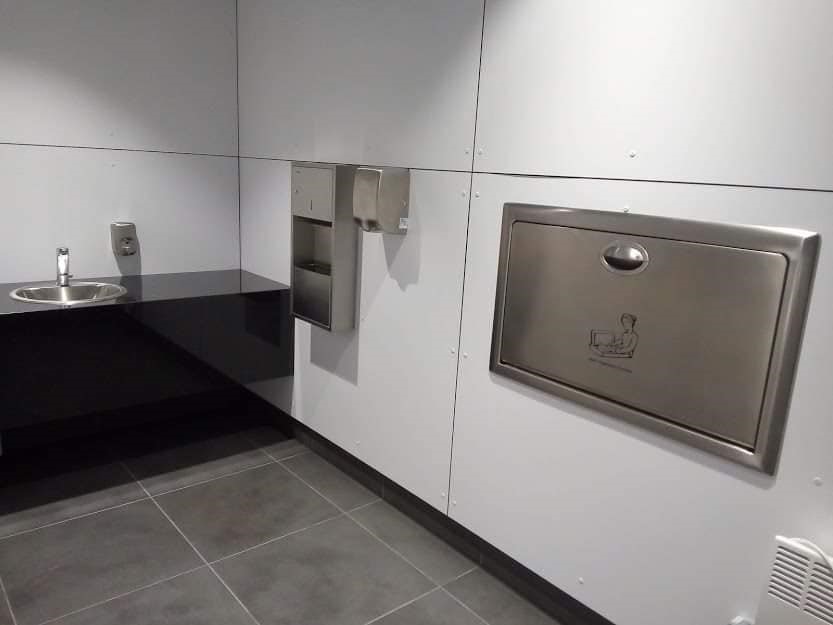How to choose a changing table for a public restroom

For every parent, the safety, comfort, and health of their children are a top priority. They want to ensure their comfort and care at every moment of their lives. It is hard to disagree that this is especially important during the early years when an infant is completely helpless and relies entirely on adult care. We must attend to all aspects, from feeding and peaceful sleep to diaper changing. The latter accompanies us for months, or even years, several times a day, which is why it’s essential to provide hygienic and comfortable conditions. As parents, we are aware of this and prepare carefully to purchase a home-changing table, but we are not always at home with the child. We move with them to various parts of the city, country, or world, sometimes stopping for a short break in a restaurant, office, shopping mall, or café, and other times for a longer stay in a hotel or guesthouse. Regardless of where we are, a child requires changing, so it is crucial that all public restrooms are as well-equipped for this purpose as possible!
If you want to equip a public restroom with a comfortable and safe changing table for children but are unsure of what to consider to make the right decision, here are some simple tips and advice to help you make the best choice.
Safety first!
The top priority is to choose a baby changing table that meets all the requirements and standards to guarantee safe use. Clearly defined standards cover the materials used, the size of the changing table, and the method of installation, opening, and maximum load capacity. Make sure the chosen model has undergone the necessary tests and has all the required certifications and approvals confirming it is suitable for sale. The equipment must also come with a user manual outlining the rules that must be followed to ensure safe use of the changing table.
When selecting a changing table, always consider its dimensions, durability, and shape, specifically checking if:
- the changing table is properly shaped—slightly concave with raised edges—to prevent the baby from accidentally falling off;
- the device's edges are not sharp, which could cause injury, and if no other dangerous elements (e.g., cords that could pose a strangulation risk) are protruding;
- the standards ensure that every child under a specific age/height/weight can easily fit on the changing table without any part of their body sticking out beyond the edges (this must be clearly specified in the user manual for the model);
- the wall-mounted changing table has passed durability tests (the maximum load must be indicated in the user manual for the model—this should distinguish between the pressure of a lying baby and the additional pressure from a leaning caregiver);
- the changing table fits the space and can be unfolded easily, allowing free movement around it for full functionality.
To choose a stable, solid, and durable changing table for children, also pay attention to:
- the material from which the changing table is made:
- it should not emit any toxic substances, such as cadmium or mercury, and should not contain harmful lead;
- it should not be made from allergenic materials;
- it should be easy to clean and maintain a high level of hygiene.
A great example of a changing table made from bacteria-resistant and skin-friendly polyethylene is the PANDA Fanecomodel. It is certified by PZH, confirming its quality, the highest level of safety, and functionality.


Photo: Horizontal folding changing table for children and infants PANDA by Faneco.
Make sure the changing tables have the appropriate safety features, such as:
- proper labels/graphics/tags reminding caregivers to exercise caution;
- safety straps and how to use them—it’s crucial that the straps can be fastened easily with one hand, allowing the caregiver to hold the baby with the other;
- secured opening and closing mechanisms to prevent any part of the baby’s body from being pinched or struck by a falling part.
An ideal example of such a changing table is the FBCTXIH Faneco. It is equipped with easy-to-use safety straps, clearly labeled infographics, and a folding mechanism based on pneumatic actuators that allow full control over the opening and closing process.

Photo. Folding horizontal changing station for children and infants - VBCTH by Faneco.
Choosing the right changing table is a challenging and responsible decision because it directly affects another person's safety. However, when making a purchase, you should also consider additional factors such as visual appeal, ease of cleaning, or installation simplicity. Your choice should be based on your taste, financial options, and fitting the changing table to the size, finish, and character of the facility where it will be installed. Remember to pay attention to extra accessories that can make changing a child easier, such as wipe holders or hooks for hanging a bag. It’s also essential to place the changing table in a location that maximizes comfort. The optimal height for a wall-mounted changing table is 90 cm from the ground.
 Photo: Folding horizontal changing station for children and infants, satin stainless steel - FBCTXSH, Faneco
Photo: Folding horizontal changing station for children and infants, satin stainless steel - FBCTXSH, Faneco
In summary, while equipping a public restroom with a changing table for children is not a sanitary requirement, it certainly helps parents in their daily routines, increasing the comfort, safety, and convenience of traveling with children.
Czytaj także:
Przewijaki dla niemowląt
Przewijaki dla maluchów
Łazienki szkolne - wymagania, projekt, wyposażenie
Łazienki w przedszkolu - wymagania, projekt, wyposażenie
Łazienkowe kosze metalowe na śmieci
Poznaj nasze kompleksowe:
Wyposażenie toalet publicznych dla architektów i projektantów
Wyposażenie toalet dla firm budowlanych i deweloperów
Wyposażenie łazienek dla niepełnosprawnych
Wyposażenie łazienek dla HoReCa







 Polski
Polski
 Český
Český
 Deutsch
Deutsch
 Spanish
Spanish
 French
French
 Italian
Italian